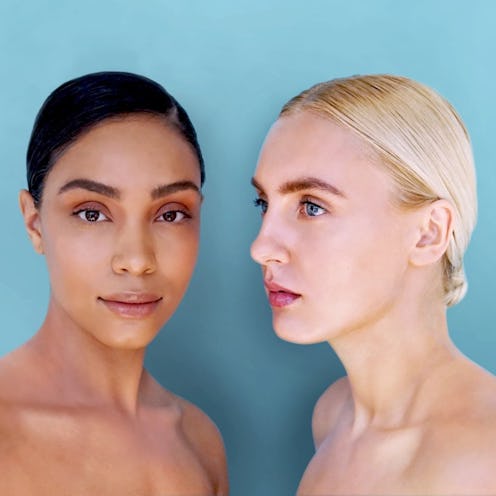(Beauty)
Blue Butterfly Pea Skincare Is The Prettiest Ingredient We've Ever Seen

Plants are wild, man. I don’t mean that in the literal sense (although, of course, that’s also true). I mean it in the awe-inspiring, beyond-comprehension, mind = blown sense. For instance, while researching blue butterfly pea flower for skin (a new product from Sonya Dakar features the ingredient), I learned that back in the day, herbalists would identify a plant’s particular powers based on what it looked like. “A good example is walnuts,” Lauren Haynes, a clinical herbalist and the founder of Wooden Spoon Herbs, tells me. “They’re so good for the brain, being full of essential fatty acids, but they also look like little tiny brains.” Guess that explains why butterfly pea isn’t traditionally used as a skincare ingredient, then…
“Butterfly pea looks like a clitoris,” Haynes states matter-of-factly. “In fact, its Latin genus is Clitoria ternatea, named for the resemblance.” As such, the cerulean-hued flower is often used in teas and tinctures as an aphrodisiac — it’s even thought to contain natural cyclotides, which are compounds that have supposed “anti-HIV effects." Luckily, thanks to modern scientific studies, we now know that blue butterfly pea is, uh, more than meets the eye. Research has found the flower is bursting with beauty benefits, too.
“I knew I needed to create some great recovery products that not only soothe and strengthen skin's barrier function, but are natural and sustainable,” Sonya Dakar, famed aesthetician and founder of her namesake beauty brand, tells The Zoe Report. During her research, she came across the blue butterfly pea flower and realized it has antioxidant and anti-inflammatory properties — two things that are very, very good for compromised skin. She’s now officially the first to incorporate the ingredient into a mainstream skincare product: the newly-launched Sonya Dakar Blue Butterfly Balm.
“Blue butterfly pea is rich in polyphenols, or proanthocyanidin, and flavonoids, which stop the harmful effects of free radicals that damage and degrade skin,” the aesthetician explains. “Proanthocyanidin is one of the most powerful antioxidants; it is able to increase the collagen and elasticity in skin cells. The result is firmer, plumper skin and a healthier complexion.” Even derms can’t deny the plumping power of polyphenols. “The antioxidants in blue butterfly pea flower can increase collagen production and prevent wrinkles,” Dr. Devika Icecreamwala, a board-certified dermatologist, tells TZR.
Antioxidant flavonoids also do more than protect from pollution damage; they help tame inflammation, too. “This is why the Blue Butterfly Balm is so effective in calming skin and visibly reducing redness,” Dakar says. “Those suffering from rosacea and eczema can greatly benefit from the calming effects of the balm.” From an herbalist’s perspective, this checks out. “According to the herbal doctrine of signatures, plants that are blue are used to calm and cool the body,” Haynes says; since cool blue is the natural opposite of fiery red. (I mean, really — this stuff is wild, is it not?)
The soothing, anti-inflammatory effect is amplified in the Blue Butterfly Balm thanks to “numerous super-antioxidants that offer protection and relief,” Dakar says; like rosehip oil, blue tansy oil, and shea butter. With a thick-but-not-too-thick texture, the blend is ideal for treating dry or dehydrated skin (AKA winter skin — it’s coming). “Flaky from a peel or retinoids? Blue Butterfly Balm instantly smooths and soothes,” the creator shares. “Red from rosacea or acne? Blue Butterfly Balm erases redness without clogging pores. Dry and dull? Blue Butterfly Balm is an excellent overnight hydrating treatment. Slather it on before bed and wake to glowing, dewy skin.”
Best of all, there aren’t any major risks to note, per Dr. Icecreamwala. Barring an allergy, the balm is safe for all skin types. And if you’re intrigued by blue butterfly pea flower’s other purported benefits? Pour yourself a cup of butterfly pea flower tea and enjoy. (Wink, wink.)
Shop Blue Butterfly Pea Flower
This article was originally published on